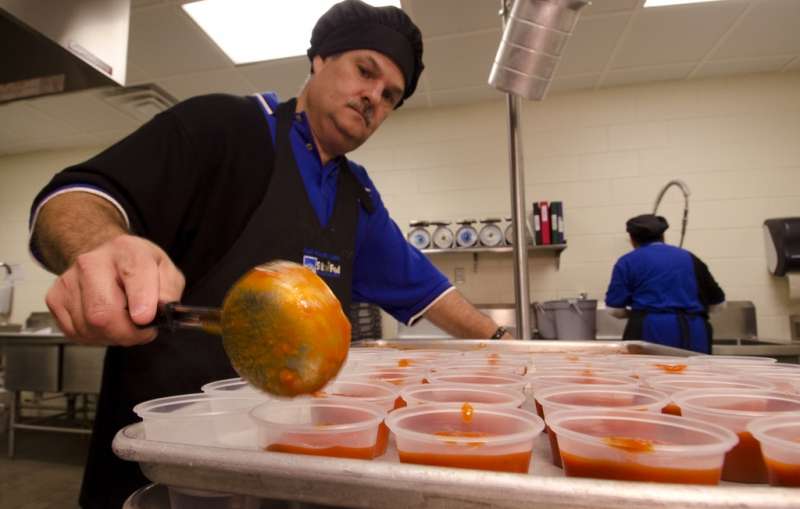USDA School Lunch Problems Continue
New research paints a rosy picture of the program. But is the picture telling the whole story?


Earlier this month, JAMA Pediatrics, published by the Journal of the American Medical Association (JAMA), posted a new study on the impact of the Healthy, Hunger-Free Kids Act, the controversial 2010 school-lunch reforms championed by First Lady Michelle Obama and passed by Congress.
The study, by four University of Washington researchers, looked at nearly 1.75 million meals served at three middle and three high schools in Washington State between 2011 and 2014.
The researchers sought to determine the nutritional quality of foods chosen by students, along with school lunch participation rates, both before and after the implementation of the new school-lunch standards mandated under the Healthy, Hunger-Free Kids Act of 2010.
The authors are clearly HHFKA fans. The first paragraph of their op-ed describes the school-lunch reforms in glowing terms, with words like "important," "tremendous," and "dramatically" used to label the reforms.
They conclude that students are selecting healthier food and eating fewer calories under the new law. They also conclude that the new law did not—contrary to numerous reports in recent years—reduce student participation in the school-lunch program.
In an op-ed that appears alongside the study, a pair of University of Maryland researchers, Erin R. Hager and Lindsey Turner, both researchers with the University of Maryland School of Medicine, argue that if student resistance to HHFKA meals existed, it has all but ended. They point to research they say shows "that any initial reactivity by students to the meal pattern changes quickly dissipated and the argument that students are abandoning school meals programs in droves is not valid." They also point to "anecdotal reports from schools on declines in lunch participation" after the HHFKA reforms. Hager and Turner also discount the problem of food waste, claiming that "plate waste has not been problematic."
Taken as a whole, both the Washington State study and the Hager and Turner op-ed paint a rosy picture of the USDA National School Lunch Program. But is it an accurate one?
For example, many students eligible for free- or reduced-price meals at the Washington State schools chose not to participate in the school-lunch program.
The authors are correct that the decrease in participation is statistically tiny. Their data showed only a slight decrease in meal participation at the schools, from 47 percent to 46 percent, after implementation of the HHFKA reforms. But because 54 percent of students at the Washington schools that were part of the study are eligible for free and reduced-price meals, we can conclude that a significant percentage of students eligible for no-cost or low-cost meals chose not to participate in the program.
That's meaningful because data on participation in the broader USDA National School Lunch Program are grim, and worsening.
According to federal government data, the USDA School Lunch Program served 258 million fewer lunches in 2014 than it did at its high point, in 2010. The number of students paying full price for school lunches today—now 8.8 million—is at its lowest point in recorded history.
Data on the amount of food waste the National School Lunch Program promotes are equally grim. One study estimates that the amount of food waste caused by the USDA National School Lunch Program each year could top $1.23 billion. Another study, this one by the federal government's own nonpartisan General Accountability Office, found that nearly every state—48 out of 50—reported they "faced challenges" from food waste under the HHFKA rules.
As I've noted before, kids whose families can afford for them to eat something else than USDA school lunches are doing just that. Increasingly, only kids who must eat school lunches do so. The Washington State study shows that even kids whose families are struggling to make ends meet are turning away from the program.
What's more, "participation" is a weasel word if ever there were one. For example, students "participate" in a meal by "taking" a meal, but may never eat the meal. That problem—which leads to increased food waste—is one that existed before the HHFKA reforms but which much anecdotal and some hard data shows has happened with greater frequency after the 2010 reforms. And students may be "offered" the increased servings of fruits and vegetables mandated under the law, but they may not "take" those increased servings.
Reports have taken note of this severe weakness of the Washington State study.
"One limitation of the study is that the researchers looked at the foods that were selected by the students and did not look at whether they ate the items," a Time piece on the new JAMA Pediatrics study notes.
So are kids eating healthier food? This study—like many others—doesn't answer that question. While it has a good deal to say about participation in the USDA's National School Lunch Program, it has little or nothing to say about whether or not the food students take is being eaten.
I think there are far better ways to feed hungry students than relying on the USDA to do the job. I'd love to see an end to the National School Lunch Program. In its place, I'd love to see better alternatives. I've proposed one such alternative, in detail, here.
If researchers choose to wear rose-colored glasses to describe the National School Lunch Program, they're free to do so. But it's important to recognize they're not seeing straight.


Show Comments (34)